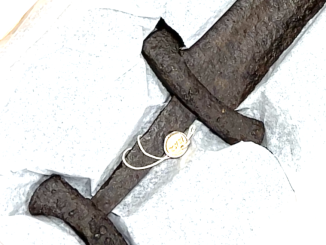While I was in Iceland, I had an opportunity to visit the National Museum of Iceland and take a look at a couple of historic axes found on the island. Since these are really outside my area of expertise, two experts generously offered to join me on the video to help explain the history and context of these swords. First we have Ármann Guðmundsson, an archaeologist with the Museum who can speak to the weapons of the time as they are found today. Second is Reynir Óskarsson, a Viking combat researcher with Hurstwic who can help us understand how these axes were actually used.
Viking-age Iceland was a unique society in many ways, and the role of personal weapons in that time is a fascinating story. So sit back and join us to learn more about it!
Many thanks to the National Museum of Iceland for bringing out these incredible thousand-year-old artifacts to show us. If you are in Reykjavik the Museum are a must-see stop:
https://www.thjodminjasafn.is/english/




Eagerly awaiting the resident experts exhaustive experience regarding this topic, specifically how they’re worse than the SA80 but not as bad as the M60.
According to a couple of different articles I have read, the bearded axe was used in ship or boat making due to the ability to plane or shave wood to shape that required a thinner finer edge than felling and splitting axes. There are a wide array of axe designs from around the world with some being strictly for fighting and others designed to be the multi-purpose tool of the time. Loved the videos from the Icelandic Museum on the archaeolocial finds.
The Norse axe was probably more akin to the Nepalese kukri in that it was more a daily tool of the people than it was an intentional weapon… And, that the daily use as tool fed into the way it was used as a weapon.
Swords were the “sexy” thing, the mark of a professional fighting man, at least in popular belief. Because of that, they had the cachet. The actual reality of combat, however? The spear and the axe, both things that the average person had available to hand for day-to-day life, were the actual “implements of war”. Spears were things used for hunting, and dealing with large predators like wolves and bears; you’d almost always have something like that to hand, in those days.
The sword, on the other hand? A quasi-ceremonial thing, intended strictly for killing. Everything else was plausibly dual-use. And, in all likelihood, far more likely to actually be used and which thus did most of the actual killing.
I’d wager that there is a similar dichotomy almost everywhere in history, even into the stone age. Purposeful weapons were high-prestige items, and relative rare. The real killing tools of the battlefield were almost certainly those daily-use items like the axe and similar tools.
Which isn’t to say that the necessity for them to be used as effective weapons didn’t influence their designs; you can clearly see some features of those bearded axes that were there because they’d be better as weapons for having them. I sat through a class on old-school woodworking tools, and the instructor was showing us how you’d have your broadaxes with the blades canted to one side or another, in order to make squaring the timber off easier. The straight-on ones were generally not preferred for that work, but he couldn’t say as to why you never see any of the ancient axes they recover being similarly canted to assist in that task… It’d be my speculation that this is perhaps less a reflection of increasing specialization and technique as time goes on, and more one of “Yeah, I may need to bury this sucker in someone’s neck, some day…”
The huge variety of different axe heads and styles just here in the United States during the major logging years stretching across North America from the New England states to the Pacific Northwest is something to marvel at. One branch of my maternal ancestry came over with the Dutch, started logging in New York during the 1600s, and didn’t stop until they ran out of trees in Oregon back during the late 1920s. Somewhere, there’s a collection of tools that one of the great-uncles put together, and they showed a clear evolution and increasing sophistication from start to finish. I wish I knew what happened to that collection, but I believe it went to a museum somewhere in Northern California or Oregon. He didn’t have the original family tools from the beginning, but he’d managed to get some authentic axes and adze heads from the late 1600s that were out of the same region the family started in. Fascinating stuff; you supposedly can work out whether the blacksmith forging the tools was Dutch, English, or French Huguenot just from the styles of how they did the forgings.
Perhaps it is worth adding that the Vikings arrived at an island of which roughly 1/4 – 1/3 was covered by (sub)arctic birch forests. Over not-so-long times they busily converted these trees to the said axes. And this stays this way; deforestation is usually irreversible, in the time framework of human history.
My reading would indicate that the introduction of sheep and goats were far more destructive than anything else.
You have to marvel at it all, when you contemplate the way that pelagic humanity was so prone to deforesting the islands they managed to reach. About the only region we didn’t do that was the Pacific Northwest, where the trees are almost impossible to eradicate, no matter how hard you try.
Both Greenland and Iceland were dependent upon the forests of Norway for their ships, and one of the reasons they were so interested in North America, or as they called it, “Vinland”, were the trees there. It’s hard to be a Viking without the necessary ships…
Other than hunting large animals, a spear won’t have much use outside of conflict. Even so, a ‘boar spear’ and a ‘neighbor spear’ might still be identical. I’d suspect that most axes were available for dual purposes. If Bjorn is acting up again, go to the woodpile and fetch the ‘armour crusher.’
A fair amount is known about the physics of axes so that handle length can be determined. Likewise, the performance of various edge shapes has been assessed. I think that replicative experiments could be done to come up with good understandings of how these pieces could have been used and how they would perform.
Guys…guys…it’s an axe. It cuts stuff too big for a knife. There’s no need to torture this with research. You—the descendants of folk who made the axes in question—are dying culturally and demographically. And you pursue HOBBIES? Cosplay never yet saved a cultu—aw, the hell with it.